WHO ARE NASSARPURIS?
The roots of my family lie in a small town Nasarpur, 45 km away from Hyderabad in Sindh province of present-day Pakistan. It is believed to be existing since the Indus Valley civilisation. It is named after Ameer Naseer who, at the behest of Sultan Feroz Shah Tulkh, rebuilt the city that was destroyed. Nasarpur gained prominence during the rule of Emperor Akbar as it was a major city used for the transport of goods between Delhi and Sindh. Today it is famous for its khes (a double-woven patterned blanket), ceramics (hand-painted glazed tiles and pottery called kashi kari), galeecha sazi (carpet work) and some archaeological sites. It is a holy place too as it is the birthplace of Jhulelal, the deity of Sindhi Hindus.
At some point in history, my ancestors left Nasarpur to settle in Karachi, probably for better prospects. Today we are known as Nassarpuris(yes, we spell it with a double ‘s’), the Sindhis from Nasarpur.
MY MATERNAL FAMILY
My mother’s father, Mr. Bhagwandas Watoomal Somaya, and his brothers had a reputed dry fruit shop M/S Watoomal Rochiram in Karachi. They owned a building with a huge shop downstairs and living quarters upstairs. My mother recalls playing with her siblings and cousins among the sacks of dry fruits in the storehouse. The children also helped in shelling pistachio and walnuts for sale. The family was highly influential and respected in Karachi. They moved about in horse carriages and were given special seats when they visited the theatre for films. My maternal grandmother, Mrs. Savitri Somaya , came from a very rich family, the Mangtanis. They had a palatial house with silver chairs and vases. They had an airplane parked in their garden, though it had never been flown. My grandmother talked about her brother’s wedding party when she was 8 years old. The Britishers who were guests at the wedding, would shake her hand and remove one of the many gold bangles from her wrist. My grandmother burst into tears and ran to her father, who assured her that he would get new ones made for her.
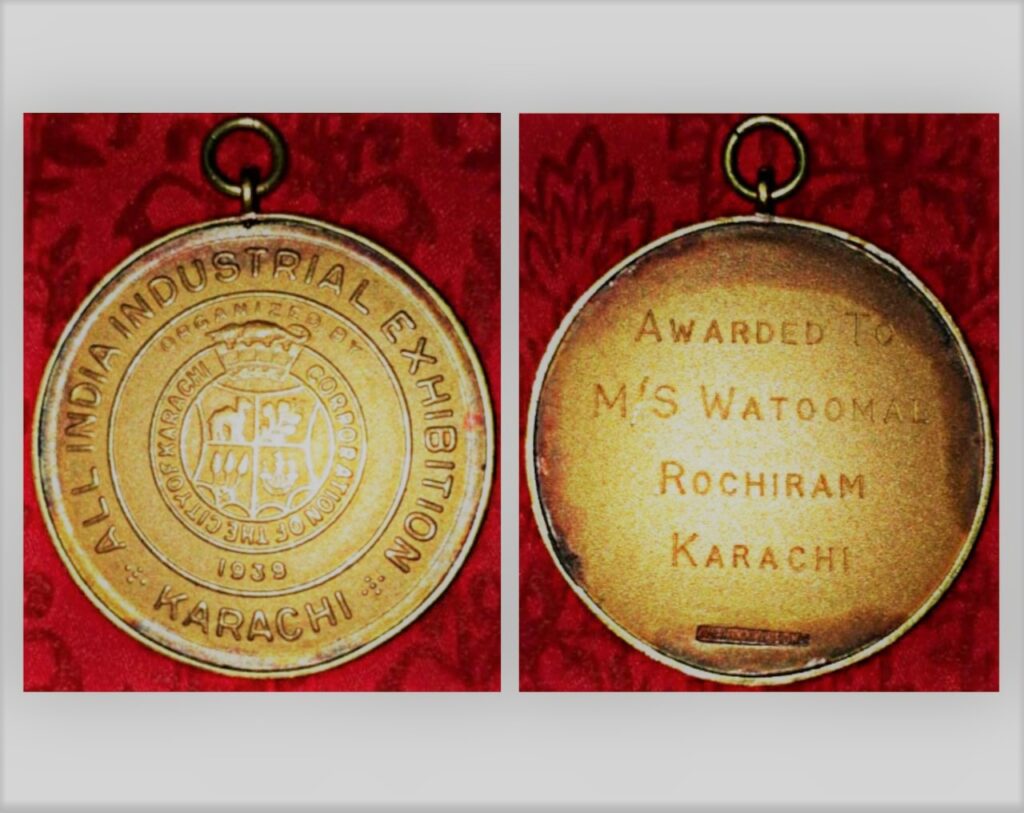
Photo Credit: Vivek and Jitendra Dalwani
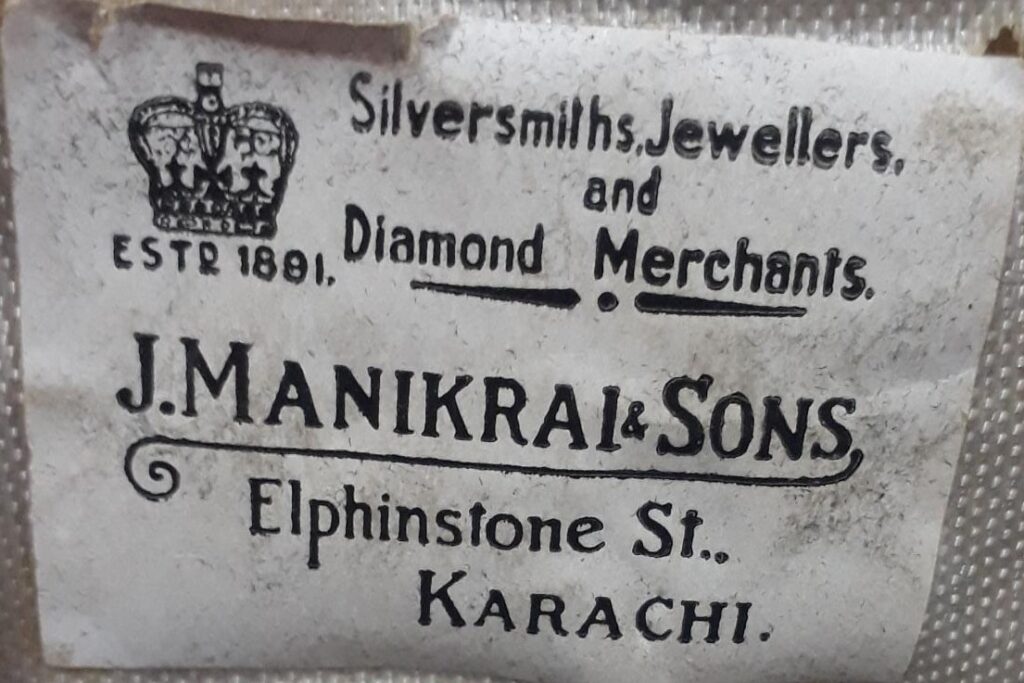
During the partition, the dry fruit shop of my grandparents was raided. A huge crowd shouting, “kaafiro ko looto” barged into the shop, opened the containers, and flung the dry fruits in the air. The staff escorted the customers quickly to the house upstairs, but one unfortunate customer, a young man who had been recently married, was stabbed in the back. The women in the house fainted. The brothers had to take an immediate decision to leave their homeland. People were leaving by ships, trains, and planes, whichever mode of transport was available at that time. My mother’s family left for India, leaving behind their thriving business, their beautiful house, most of their possessions and wealth.
They reached Navsari and tried to set up dry fruit business there, which did not work out. So, they took off for Bombay, now Mumbai, where many Nassarpuri families had already settled. Here, the brothers parted ways and each started their own business. My grandfather supplied homemade spice masalas to hotels and restaurants. But the family could never regain the prosperity they lost during the partition.
MY PATERNAL FAMILY
My paternal grandfather, Mr. Kishinchand Bhojraj Davara, was a wholesale tea and grain merchant. My paternal grandmother, Mrs. Radhika Davara, was good at embroidery and cooking. Inspired by Gandhiji, she wore hand-spun sarees and participated in the freedom struggle. Post partition, my father’s family moved to the port city Bhavnagar, Gujarat. The Maharaja of Bhavnagar had opened the royal stables to put up people who came without any money to sustain themselves. My grandparents had some money with them. They rented a house and started a cloth, readymade, and woolen clothes business. By the time I was born, some 20 years later, my family was comfortably off. They had managed to find their foothold in a strange city with a culture diametrically different from their own.
Both my grandfathers, Kishinchand Bhojraj Davara and Bhagwandas Watoomal Somaya, worked selflessly for the rehabilitation of the Sindhis. They would wait at the railway stations receiving people who came from Sindh, helping them to settle in camps set up by the Indian government. My paternal grandfather also set up a clinic for the poor, where doctors offered free consultations. He started a Sindhi school in Bhavnagar too.
MY DEVOTIONAL HOUSEHOLD
My mother, Mrs. Sarla Davara, observed all the Sindhi rituals and festivals. Kanaw prasad (a sweet made with roasted wheat flour, ghee, sugar) was prepared for Cheti Chand, celebrating the birth of Jhulelal and the Sindhi Hindu New Year. My father made thadal (milk, fennel seeds, poppy seeds, rose petals, almonds, cardamom powder, black pepper, sugar – all finely ground together and filtered through a muslin cloth) for Shivratri – the wedding anniversary of Shiv and Parvati. The entire family observed fast that day. Janmashtami, Diwali, Navratri, Holi, Raksha Bandhan – each festival had its own set of rituals to be followed. There was a lot of emphasis on daan – giving charity, on important days according to the lunar calendar. Makar Sankranti falls on 14th January, the day the sun begins its northward journey and marks the end of winter. On this day, my father would set out thalis (plates) – one for each member of the family. He would put a bowlful of rice, moong, sugarcane, radish, bhorinda (sesame seeds and sugar balls), ghee and some kharchi (money). We would touch our respective thali, the contents of which would be given to each of the three – bambhan (the Brahmin), the temple and the poor. Whenever anything that was made during the festivals such as Nandi satte (the seventh day of Shraavan month according to the lunar calendar) or Vadi Satte (the 21st day of Shraavan), a portion each was set for the above three.
Satnaran ji kutti (dry roasted wheat flour in ghee mixed with sugar made for the full moon day) with sliced coconut, peanut, and chopped fruits was offered to the deities on full moon day as prasad. My mother would always light a diyo (lamp)in the morning and evening in front of the Tulsi (the holy basil) plant and add Tulsi leaves to the pot of drinking water. She also fed flour and sugar to the ants in the garden in summer.
We had a small wooden temple with picture frames of various gods – Ram, Shiv, Ganpati, Ambe Ma, etc. and a small idol of Bal Krishna in a swing. The daily puja (which involved cleaning the temple, bathing the idol, offering prasad and lighting the lamp before gods) was often outsourced to me, which I did happily. For me, the little Krishna was a doll I dressed up with lovely vagaas (clothes for idols of gods) handstitched by my creative sister. A lot of detail went into making these clothes – she would take a rich shimmery piece of cloth, cut it to the right size and shape with a hole in the centre for the head, and hem every open side with tiny stitches. Next, she would carefully choose the trimming to go with the dress and stitch it as a finishing touch. They were the most beautiful clothes I have ever seen.
My father. Mr. Jaikumar Davara, loved reading books. We had huge cupboards full of books in Gujarati, Hindi, and English ranging from fiction and poetry to spiritualism. He had a dealership for religious books of Geeta Press, Gorakhpur. He often regaled us with stories from Ramayana, Mahabharat, Puranas, and other mythological books. He had in-depth knowledge about various religions too- he had read Vedas, Bible, and Quran (I have his copies with me) and helped Ph.D. students with their thesis on religious topics.
THE NASARPURI FOOD
My mother’s family were hardcore non-vegetarians. They ate mutton and fish prepared the Sindhi way. But since my father’s family was vegetarian, my mother made delicious vegetarian Sindhi food. She would put a bit of everything she had cooked on the first phulka (whole wheat flatbread roasted on the griddle pan) she made and offer it to the cow. The last phulka was always for the dog. She combined different kinds of rice preparations with various vegetable dishes. Every vegetable dish was served with rice cooked in a particular manner. Vegetables like potatoes, cauliflower, brinjals, lady’s finger, etc cooked in sayal masalo ( a coarse paste of coriander leaves, chillies, garlic, coriander powder, salt, and turmeric powder) would be paired with daal pya chokha (rice cooked with moong dal in ghee). Sai bhaji ( a spinach based dish with fenugreek leaves, dill leaves, sorrel leaves, channa daal, tomatoes, carrots, brinjals, bottle gourd, potatoes, chillies, ginger, etc) would be paired with peas wara chokha( rice cooked with peas sprinkled with shahijeero (caraway seeds)) or bhugal chokha ( rice cooked in sliced onions sautéed to a golden brown colour). We had phulkas, some dry bhaji (vegetable cooked in masalas) and curds to go with these combinations. My absolute favourite pairing was tamataa batata (potatoes in tomato gravy)– peela chokha (rice with mustard seeds and turmeric) and dahi (curds). I have included the recipes of the pair at the end of the post.
Breakfast was sometimes loonwari poori (pooris with salt and carrom seeds or with coriander leaves and finely chopped chillies) with fried papads and tea. We cousins when we met for holidays would polish off a jaw-droppingly large number of pooris till my elder sister, the designated cook of the family when my mother was busy, would scold us into stopping.
Five Facts about Nassarpuris:
- The existence of the ancient city Nasapur harks back to the Indus Valley Civilisation. Its real name is Mata Lui. There are some archaeological sites and ruins that prove that Nasarpur has a rich historical past.
- Nasarpur has a rich tradition of handiwork that has evolved over centuries. Its hand-painted glazed tiles, pottery, tables, mosaics, and murals are famous all over.
- The fertile plains of Indus provide a major source of income in agriculture for the people of Nasarpur. The region is famous for its mangoes and onions.
- The town of Nasarpur is of religious importance to Sindhi Hindus as it is the birthplace of Jhulelal.
- Today, Nassarpuris are scattered all over the country and world. But like pearls in a single strand, all Nassarpuris are bound by Pujya Nassarpuri Panchayat Federation, whose head office is in Mumbai. The Federation ensures the unity and well-being of the community.
Here’s the recipe of Tamataa Batata- Peela Chokha:
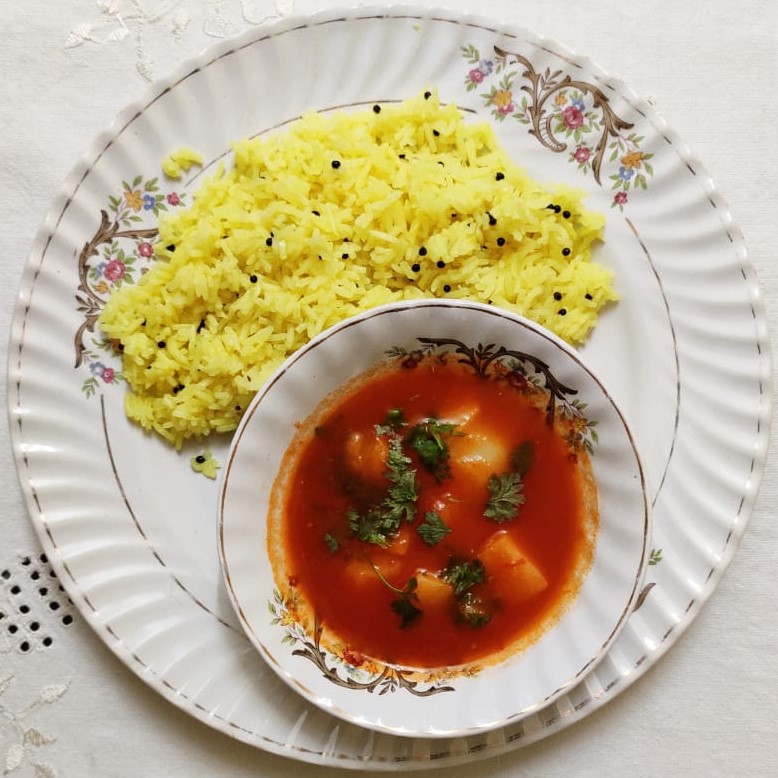
Tamaata Batata: (serves 2 – 3)
Ingredients:
Tomatoes: 4
Potatoes: 3
Peas: ½ cup (50 gm)
Ginger paste: I tsp
Chillies: 1-2 chopped
Asafoetida: 1 tsp
Turmeric powder: 1 tsp
Salt to taste
Coriander leaves for garnishing
Mint leaves (optional)
Oil for cooking
Procedure:
- Chop the tomatoes. Heat oil in a vessel. Add 1 tsp asafoetida. After a few seconds, add chopped chillies, ginger paste, and chopped tomatoes. Add a little water. Cook the tomatoes till done.
- Blend the tomatoes. Add potatoes and peas. Add turmeric powder and salt. Pour a little water. Cook till done.
- Garnish with coriander leaves and mint leaves.
Peela Chokha (serves 2-3)
Ingredients:
Rice- 300 gm
Chopped chillies- 1-2
Mustard seeds- 2 tsp
Turmeric powder- ½ tsp
Salt to taste
Oil for cooking
Procedure:
- Heat 2 cups of water. Keep it aside.
- Heat oil in a vessel. Add mustard seeds and let them sputter.
- Add chopped chillies and rice. Pour the hot water in it.
- Add turmeric powder and salt to taste. Stir.
- Cook till the water starts drying.
- Lower the flame of the stove. Place a griddle under the vessel. Stir the rice with the end of the handle of the cooking spoon and cover it with a lid. Place a heavy object such as the mortar on it.
- Let the rice cook in its steam for 10 minutes.
- Serve with tamataa batata and dahi (curd).
Featured Image : My maternal grandmother(the woman on the right on the chair) with other family members. The giggling girl on the chair next to her is my mother. There is an interesting reason for her giggles; she is amused at the photographer hiding under the black cloth, the way the photographs were taken then.
Photo Credit: Personal collection of the family
Jyoti Mulchandani
Ahmedabad
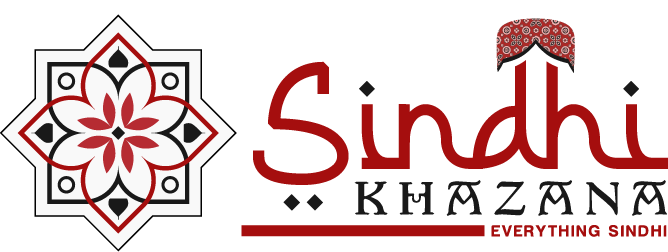
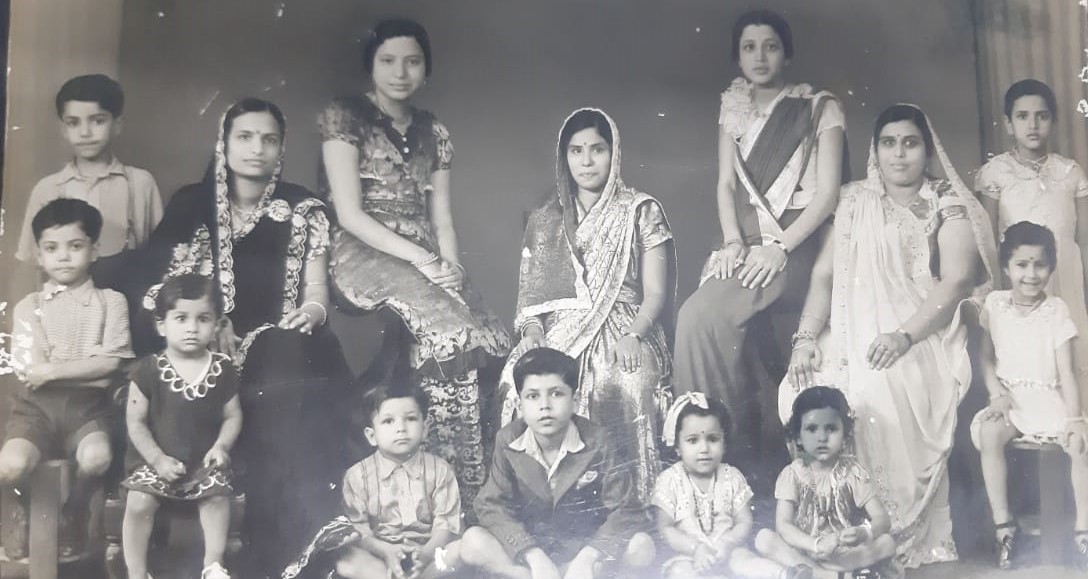
Pingback:The Nassarpuri Sindhi: Who are Nassarpuris?
Our all traditional rituals should be launched and explain thoroughly. So our young generation know importance of our community.